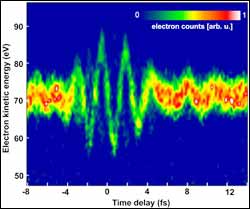Light oscillations become visible

Fig. 1: Energy shift (in units of eV) suffered by an attosecond electron probe set free at different instants (measured in units of fs) in an intense wave consisting of only a few cycles of red light. Image: Max Planck Institute for Quantum Optics / Technical University Vienna
Austrian-German research team demonstrates for the first time an attosecond “oscilloscope” rendering the hyper-fast field oscillations of visible light
The human eye can detect changes in the intensity of light, not however the wavelength because light oscillates too fast (approximately 1000 trillion times per second). An international collaboration led by Ferenc Krausz and made up of researchers from the Vienna University of Technology, the Max-Planck-Institute for Quantum Optics and the University of Bielefeld have recently succeeded in developing a technique which can measure the instantaneous electric field of red light (quarter period ~ 620 attoseconds) and record its variation with a resolution of 100 attoseconds (Science, August 27, 2004). The experiment of the Austrian-German team allowed the first direct visualization of the electric field of visible light and constitutes the fastest measurement to date.
It has been known since the famous experiments of Heinrich Hertz near the end of the 19th century that light is a wave consisting of electric and magnetic fields, just as radio waves and microwaves. The only difference is in the number of times these fields change their direction in a second. In radio and microwaves this happens typically millions to trillions times per second. The field variation in these waves can be readily detected by turning it into electric current and displaying the variation of this current in electronic instruments called oscilloscopes.
In striking contrast, the electromagnetic field of visible light changes direction approx. one thousand trillion, i.e. 1 000 000 000 000 000, times per second, so that the instantaneous intensity of the light field varies from zero to maximum faster than a femtosecond (1 femtosecond being one thousandth of a trillionth of a second), some ten thousand times more rapidly than the resolution of the fastest electronic instruments available to date. Recording the field variation of visible light calls for an oscilloscope that exhibits a temporal resolution of several hundred attoseconds (1 attosecond being a thousandth of a femtosecond). The researchers recently succeeded in developing a technique which can measure the instantaneous electric field of red light (quarter period ~ 620 attoseconds) and record its variation with a resolution of 100 attoseconds.
The key to this measurement was the generation of single 250-attosecond extreme ultraviolet pulses, a feat achieved by the same collaboration a few months ago (Nature, February 26, 2004). The attosecond extreme ultraviolet pulse knocks electrons free from atoms to probe the electric field of a wave consisting of only a few cycles of red laser light. The electric field of red light accelerated or decelerated the electrons set free with respect to the light wave with a 100-attosecond timing precision. The change in the electrons’ energy (shown in units of electron volts, eV, in Fig. 1), measured as a function of delay (shown in units of femtoseconds, fs, in Fig. 1) between the attosecond pulse and the laser light wave clearly exhibits the build-up and disappearance of the laser pulse within a few femtoseconds as well as oscillations with a period of the 2.5-fs wave cycle of 750-nm (red) light. The measured energy change directly yields the variation of the instantaneous strength and direction of the electric field of the few-cycle light wave (Fig. 2).
The red line in Fig. 2 depicts the electric field of a few-femtosecond flash of red light, as recorded by an apparatus that can be regarded as the first attosecond oscilloscope. The new technique permits direct and accurate measurement of ultrabroad-band light pulses (made up of many different colours), and thereby opens the door to the reproducible synthesis of ultrashort flashes of light with arbitrary waveform for a number of applications including the development of molecular electronics and X-ray lasers.
Media Contact
More Information:
http://www.mpg.deAll latest news from the category: Power and Electrical Engineering
This topic covers issues related to energy generation, conversion, transportation and consumption and how the industry is addressing the challenge of energy efficiency in general.
innovations-report provides in-depth and informative reports and articles on subjects ranging from wind energy, fuel cell technology, solar energy, geothermal energy, petroleum, gas, nuclear engineering, alternative energy and energy efficiency to fusion, hydrogen and superconductor technologies.
Newest articles

NASA: Mystery of life’s handedness deepens
The mystery of why life uses molecules with specific orientations has deepened with a NASA-funded discovery that RNA — a key molecule thought to have potentially held the instructions for…

What are the effects of historic lithium mining on water quality?
Study reveals low levels of common contaminants but high levels of other elements in waters associated with an abandoned lithium mine. Lithium ore and mining waste from a historic lithium…

Quantum-inspired design boosts efficiency of heat-to-electricity conversion
Rice engineers take unconventional route to improving thermophotovoltaic systems. Researchers at Rice University have found a new way to improve a key element of thermophotovoltaic (TPV) systems, which convert heat…



